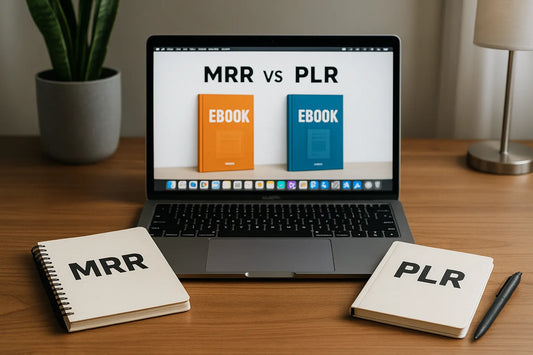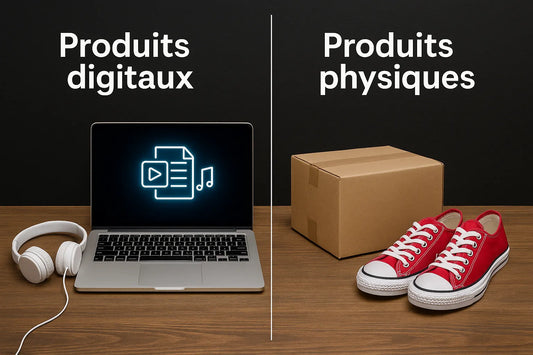Digital and physical products operate according to different logics in e-commerce: low production costs and scalability for the former, logistical management and tangibility for the latter. Let's compare their advantages and limitations to better guide your strategy.
Reading time: 12 min
Digital products VS physical products: discover the key differences, advantages and disadvantages to succeed in your e-commerce business.
- Digital products offer high margins and instant distribution.
- Physical products provide reassurance through their tangibility and perceived value.
- Logistical constraints differ greatly depending on the type of product.
- The choice depends on the business model, skills, and target clientele.
- Combining them can create a more complete and profitable ecosystem.

Digital products vs. physical products: understanding the difference
In e-commerce, the choice between digital and physical products is strategic. The former are intangible (ebooks, online courses, software), while the latter require logistical management (warehousing, shipping, returns). This choice directly impacts your costs, profit margin, and customer experience.
Advantages of digital products
Digital products appeal to many entrepreneurs because they are free from physical constraints. Once created, they can be sold indefinitely without additional production costs. Their distribution is instantaneous and global, allowing for exceptional scalability .
Margin and profitability
Profitability is the key advantage of digital products: no repeated manufacturing costs, no storage fees, no transportation. The net profit margin is often significantly higher than that of physical products.
Accessibility and automation
Digital products integrate easily into automated systems: email marketing, sales funnels, download platforms. This allows for the creation of passive income over the long term.
Advantages of physical products
Conversely, physical products remain dominant in commerce because they possess an immediate and reassuring perceived value. The customer can touch, use, and show off their purchase, which stimulates the buying process.
Trust and customer experience
A tangible product inspires trust more easily. Receiving a well-packaged parcel creates a strong emotional experience, sometimes absent from digital products.
Larger market
Everyone uses physical products on a daily basis, which greatly expands the potential market compared to digital products, which often require a specific context (computer, smartphone, suitable software).
Disadvantages of digital products
While digital products offer numerous advantages, they also have limitations. The main challenge lies in competition and perceived value. An ebook or training course can be copied or perceived as "less tangible."
- High risk of piracy and illegal copying.
- Perceived value sometimes lower than that of tangible products.
- The need to differentiate oneself through quality, support, or community.
Disadvantages of physical products
Logistical constraints are the main obstacle. Storage, returns management, delivery times – all these elements increase costs and complicate the business.
- High manufacturing and shipping costs.
- Inventory management and risk of stockouts.
- Additional costs related to customer returns.
Comparison of digital and physical products
| Criteria | Digital products | Physical products |
|---|---|---|
| Margin | Very high | Variable, often lower |
| Logistics | Automated | Complex and expensive |
| Scalability | Unlimited | Limited by production |
| Perceived value | Weaker | Stronger |
- Margin: Digital products = very high / Physical products = variable, often lower
- Logistics: Digital products = automated / Physical products = complex and costly
- Scalability: Digital products = unlimited / Physical products = limited by production
- Perceived value: Digital products = lower / Physical products = higher

Can digital products and physical products be combined?
Yes, and it's often a winning strategy. For example, a sports brand can sell physical accessories (mats, dumbbells) and simultaneously offer digital training programs. Each reinforces the value of the other and creates a complete ecosystem.
What choice is right for your business?
The answer depends on your skills, resources, and target market. Digital products require strong expertise in content creation and online marketing. Physical products demand logistical mastery and supply chain management. The right choice is the one that aligns with your strengths .

FAQ
What are the best-selling digital products?
eBooks, online courses, software, templates and subscriptions are among the most popular.
Which physical products sell best online?
Clothing, accessories, beauty products and home goods are at the top of e-commerce sales.
Are digital products really profitable?
Yes, their margin is often higher, but success depends on the quality of the product and your ability to stand out.
Can I sell both digital and physical products?
Absolutely, and this can strengthen customer loyalty by offering a complete brand universe.
Conclusion
Digital products vs. physical products: each option has its advantages and limitations. Digital products offer profitability and scalability, while physical products provide reassurance and create a strong perceived value. The most important thing is to choose or combine those that best suit your objectives and target market.
Ready to launch your store? Analyze your strengths, choose between digital products, physical products or both, and stand out today.



























































